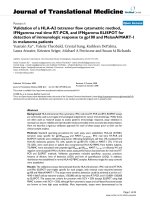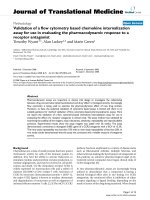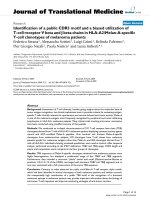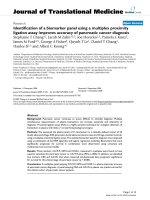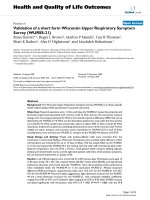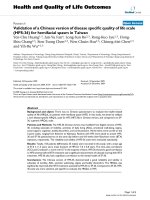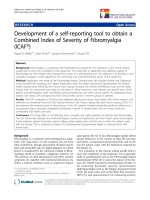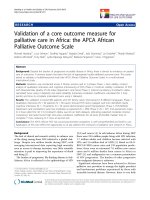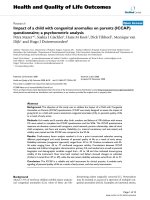Báo cáo hóa học: " Effectiveness of a Wii balance board-based system (eBaViR) for balance rehabilitation: a pilot randomized clinical trial in patients with acquired brain injury" ppt
Bạn đang xem bản rút gọn của tài liệu. Xem và tải ngay bản đầy đủ của tài liệu tại đây (2.59 MB, 10 trang )
JNER
JOURNAL OF NEUROENGINEERING
AND REHABILITATION
Effectiveness of a Wii balance board-based
system (eBaViR) for balance rehabilitation: a pilot
randomized clinical trial in patients with acquired
brain injury
Gil-Gómez et al.
Gil-Gómez et al. Journal of NeuroEngineering and Rehabilitation 2011, 8:30
(23 May 2011)
RESEARCH Open Access
Effectiveness of a Wii balance board-based
system (eBaViR) for balance rehabilitation: a pilot
randomized clinical trial in patients with acquired
brain injury
José-Antonio Gil-Gómez
1*
, Roberto Lloréns
1
, Mariano Alcañiz
1,3
and Carolina Colomer
2
Abstract
Background: Acquired brain injury (ABI) is the main cause of death and disability among young adults. In most cases,
survivors can experience balance instability, resulting in functional impairments that are associated with diminished
health-related quality of life. Traditional rehabilitation therapy may be tedious. This can reduce motivation and
adherence to the treatment and thus provide a limited benefit to patients with balance disorders. We present eBaViR
(easy Balance Virtual Rehabilitation), a system based on the Nintendo
®
Wii Balance Board
®
(WBB), which has been
designed by clinical therapists to improve standing balance in patients with ABI through motivational and adaptative
exercises. We hypothesize that eBaViR, is feasible, safe and potentially effective in enhancing standing balance.
Methods: In this contribution, we present a random ized and controlled single blinded study to assess the
influence of a WBB-based virtual rehabilitation system on balance rehabilitation with ABI hemiparetic patients. This
study describes the eBaViR system and evaluates its effectiveness considering 20 one -hour-sessions of virtual reality
rehabilitation (n = 9) versus standard rehabilitation (n = 8). Effectiveness was evaluated by means of traditional
static and dynamic balance scales.
Results: The final sample consisted of 11 men and 6 women. Mean ± SD age was 47.3 ± 17.8 and mean ± SD
chronicity was 570.9 ± 313.2 days. Patients using eBaViR had a significant improvement in static balance (p = 0.011
in Berg Balance Scale and p = 0.011 in Anterior Reaches Test) compared to patients who underwent traditional
therapy. Regarding dynamic balance, the results showed significant improvement over time in all these measures,
but no significant group effect or group-by-time interaction was detected for any of them, which suggests that both
groups improved in the same way. There were no serious adverse events during treatment in either group.
Conclusions: The results suggest that eBaViR represents a safe and effective alternative to traditional treatment to
improve static balance in the ABI population. These results have encouraged us to reinforce the virtual treatment
with new exercises, so an evolution of the system is currently being developed.
Background
Acquired Brain injury (ABI) is the main cause of death
and disability among young adults [1]. ABI can cause
from mild to severe impairments in cognitive, motor or
psychological functions leading to difficulties in familiar,
vocational and social rei ntegration which diminishes
health-related quality of life [2]. Among them, ABI can
cause different levels of paralysis, such as hemiplegia or
hemiparesis, w hich dramatically affect the balance con-
trol and, consequently, the performance of activities o f
daily living (ADL). Traditional balance training is based
on the automatic r epetition of specific movements.
These methods can become repetitive and aimless, and
thus reduce the motivation and adherence to treatment.
Balance control, as the complex const ellation of impair-
ments following ABI, demands a multidisciplinary
* Correspondence:
1
Instituto Interuniversitario de Investigación en Bioingeniería y Tecnología
Orientada al Ser Humano, Universitat Politècnica de València, C. Vera s/n,
46022 Valencia, Spain
Full list of author information is available at the end of the article
Gil-Gómez et al. Journal of NeuroEngineering and Rehabilitation 2011, 8:30
/>JNER
JOURNAL OF NEUROENGINEERING
AND REHABILITATION
© 2011 Gil-Gómez et al; licensee BioMed Central Ltd. This is an Open Access article distributed under the terms of the Creative
Commons Attribution License (http://creat ivecommons.org/licenses/by/2. 0), which permits unrestricted use, distribution, and
reproduction in any medium, provided the original work is properly cite d.
rehabilitation approach that, with the aid of new tech-
nologies, could maximize functional recovery.
In the last few years, there has been increasing
research interest in the application of virtual reality (VR)
technology to rehabilitation [3]. In contrast with tradi-
tional rehabilitation procedures, which may be tedious,
reso urce-intensive and costly, VR provides patients with
ABI opportunities to engage in meaningful, intensive,
enjoyable and purposeful tasks related to real-life inter-
ests and ADL [ 4]. T he published clinical results indicate
that the recovery of motor function in ABI patients with
motor difficulties appears to be enhanced by using VR
technology [5-7]. Although most of these studies still
consist of small experiments without randomized con-
trol trials [8], they demonstrate the feasibility of the
application of VR technology in this clinical field.
In regard to standing balance, systems based on force
platforms are particularly interesting, since they enable
to estimate the weight distribution of the patients by
means of pressure sensors [9,10]. These devices are
expensive and require a dedicated area in the clinical
facilities due to their size, weight and set-up. In this
respect, computerized dynamic posturography can assess
the ability of the automatic motor system to quickly
rec over from an unexpected external disturb ance. Some
of these systems even offer interactive and functional
training exercises that fit the patients’ conditions. In
comparison w ith these platforms, the Nintendo
®
WBB
(a peripheral of the Nintendo
®
Wii gaming system) is
an inexpensive interface (less than $100USD) that has
widespread availability. The WBB also has the advantage
of being portable, easy and comfortable to handle thanks
to its small size (0.511 m. wide by 0.316 m. long by
0.053 m. thick) and weight (3.5 kg. withou t batteries).
Furthermore, it is a device with Bluetooth wireless con-
nectivity that is battery operated. The WBB contains
four force sensors (located in each corner) that are used
to measur e the user’s center of balance and weig ht. F ol-
lowing the Nintendo
®
gaming philosophy, users can
interact naturally with the game (by means of weight
transferences).
The number of studies that include Nintendo
®
Wii or
WBB in the rehabilitation process is increasing but still
limited. Saposnik et al. evaluated the feasibility, safety
and efficacy of VR rehabilitation u sing the Nintendo
®
Wii gaming system with entertainment software to
improve arm motor recovery in stroke patients [11].
Since t he study is focused on improving arm recovery,
the WBB was not used. Deutch et al. also use commer-
cial software (Wii sports) t o describe the feasibility and
cli nical efficacy of Nintendo
®
Wii to augment the reha-
bilitation of an adolescent with cerebral palsy [12]. Loh
et al. use this system as well and reported improvement
in a group of patients with stroke in a non-controlled
study [13]. Sugarman et al. report the feasibility and
outcome of the WBB with a commercial program for
balance training after stroke [14]. Although this software
is not designed for balance recovery after stroke, they
highlight i ts potential to be used in clinical settings in
order to imp rove balance. In this sense, Clark et al. [15]
demonstrated the convergent validity and the clinical
utility of the WBB compared to a laboratory-grade force
platform, which is considered the gold standard measure
of balance. The results suggest that the WBB could be
considered as a valid portable low-cost tool for assessing
standing balance. However, the Nintendo
®
Wii and
WBB are entertainment systems oriented to healthy
people that offer a gaming experience that differs from
the t herapy required by patients with ABI [ 16,17]. This
fact has encouraged different authors to develop custom
made applications oriented to diminished people using
the WBB [18-22]. However, they are still very concep-
tual designs or lack more powerful studies to evaluate
their efficacy.
Therefore, we designed eBaViR, a virtual rehabilitation
system for balance recovery that provides motivational
task oriented exercises specifically designed for ABI peo-
ple by clinical therapists. The system can fit the patients’
impairment to provide a particular training session,
allowing the therapists to customize the duration and
difficultyofexercisestotheneedsofthepatientsin
each session.
The aim of this study is to evaluate the efficacy of the
eBaViR system as a rehabilitation tool for balance recov-
ery. In this contribution, we present a randomized and
controlled single blinded trial to evaluate the influence
of eBaViR on balance rehabilita tion of ABI patients. We
hypothesize that eBaViR is feasible, safe and potentially
efficacious in enhancing standing balance.
Methods
Participants
Seventy-nine hemiparetic patients who had sustained an
ABI a nd were attending a rehabilitation program were
potential candidates f or participation in this study. The
inclusion criteria were: 1) age ≥16 years and <80 years;
2) chronicity > 6 months; 3) absence of cognitive
impairment (Mini-Mental State Examination [23] cut-off
>23); 4 ) able to follow instructions; 5) abili ty to walk 10
meters indoors with or without technical orthopaedic
aids. The exclusion criteria were: 1) patients with severe
dementia or aphasia; 2) patients whose visual or hearing
impairment does not allow possibility o f interaction
with the system; 3) patients with hemispatial neglect; 4)
patients with ataxia or any other cerebellar symptom.
After inclusion-exclusion criteria, a final consecutive
sample of twenty patien ts remained from the total pool.
This sample was divided into two groups according to
Gil-Gómez et al. Journal of NeuroEngineering and Rehabilitation 2011, 8:30
/>Page 2 of 9
the Berg Balance Scale score. Group A was made up of
subjects with a high risk of falling, with Berg scores ran-
ging from 30 to 45. Group B was made up of subjects
with a low risk of falling, with a Berg score ≥46. All the
subjects from both groups were randomly assigned to
either a control group (traditional physiot herapy) or a
trial group (eBaViR therapy). The randomization sche-
dule was computer-generated using a basic random
number generator. Two patients of t he control group
and one patient of the trial dropped out of the treat-
ment due to causes unrelated to the study and system,
and, consequently, their data are not included in the
present c ontribution. The final sample c onsisted of 11
men and 6 women ranging f rom 16 to 76 years old
(47.3 ± 17.8) and a mean chronicity of 570.9 ± 313.2
days. Etiology of acquired brain injury in this group of
patients included severe traumatic b rain injury (TBI) (n
= 3), ischemic or hemorrhagic stroke (n = 11), and
benign cerebral neoplasm (BCN) (n = 3). Table 1 shows
a summary of the characteristics of the subjects.
None of the participants had previous experienc e with
virtual rehabilitation therapies. Written informed con-
sent was obtained from patients for publication of this
case report and accompanying images. A copy of the
written consent is available for review by the Editor-in-
Chief of this journal.
Instrumentation
Hardware
The hardware components of the eBaViR system consist
of a conventional PC, a 42” LCD screen and a WBB.
The communication between this device and the com-
puter is established via Bluetooth protocol. This way,
the exercises run on a PC and the system uses the WBB
as interface.
Software
As mentioned above, the eBaViR system does not use
any commercial software. The exercises have been pro-
grammed using an authoring system for interactive 2D
and 3D applications and designed with the help of clini-
cal spec ialists in balance rehabilitation. The system has
been developed with three main goals in mind: obtain-
ing a valid and adaptive system for the balance rehabili-
tation of the patients, achieving a system that reinforces
the m otivation of the patients during the rehabilitative
process and providing the therapists with objective data
of the evolution of the patients.
The first goal is achieved thanks to the interface used
in the sys tem: the pat ient interacts with the games, spe-
cifically designed by specialists, through weight transfer-
ences in sitting and standing position, which is an
essential process in standing balance rehabilitation
[24,25]. The system calibrates t he maximum excursio n
of the patients and adapts the range of motion of the
exercises to fit their impairment. In addition, the thera-
pist can configure the difficulty of the session with other
param eters (number of items, speed, etc.). This way, the
therapist can easily customize the training of each
patient.
The s econd goal is achieved by designing the system
with a playful scheme. For the patient, the system is
basically a set of three games, which make the rehabili-
tative se ssions more amenable. By means of its config-
uration, the system also tries to avoid frustrating gaming
experiences in which the patients are not able to fulfill
some tasks due to their motor or cognitive impairments.
The last goal is achieved registering the relevant out-
comes of each exercise (scores, time, etc.) and the maxi-
mum excursion of the patients.
Use
In each session, the patient plays the three games of the
system (Simon, Balloon Breaker and Air Hockey). A brief
explanation of the purpose of each one of these games
can be found in Table S1, Additional file 1. Although
their visual aspect can be similar to commercial games,
the games have been designed to optimize the visual
and audio feedback and to simplify other stimuli to
allow patients with cognitive impairments to follow the
exercises and to focus on the motor task.
The workflow is the same for the three games (see
Figure 1).
First, each game begins with an initial setup screen
(Figure 1, screen 1). This initial screen allows the thera-
pist to parameterize the game to suit the needs of each
patient. There are two sets of parameters: a set that con-
figures the rehabilitation session (such as the duration of
the session and the number of breaks per session), and a
set t hat configures the game level (such as the size or
the speed of the game elements).
Table 1 Characteristics of the participants
Issue Control group Trial Group Significance
Gender (n) NS (p =
0.858)
Male 5 (29.4%) 6(35.3%)
Female 3(17.7%) 3(17.7%)
Age (years) 49.13 ± 21.18 45.78 ± 15.38 NS (p =
0.704)
Etiology (n) NS (p =
0.657)
Stroke 5 (29.4%) 6 (35.3%)
TBI 1 (5.9%) 2 (11.8%)
BCN 2 (11.8%) 1 (5.9%)
Time since injury
(days)
675.50 ±
283.11
478.00 ±
324.77
NS (p =
0.204)
The table shows the information of the patients. Age and time since injury are
defined in terms of mean and standard deviation. Etiology is also expres sed
as a percentage of the total number of patients. NS: non-significant.
Gil-Gómez et al. Journal of NeuroEngineering and Rehabilitation 2011, 8:30
/>Page 3 of 9
ABI pati ents frequently have hemiparesis. One of the
most characteristic consequences of incomplete recovery
from hemiparesis is that there is a weight-bearing asym-
metry in favour of the non paretic leg as well as
incre ased spontaneous postural sway [26,27]. Because of
this, the next step after configuration is to automaticall y
adjust the sensitivity of the WBB to each patient’ s lim-
itations (Figure 1, screen 2). The system is designed to
record the centre of balance in the resting position of
the patient and his/her range of motion in both the
antero-posterior and medial-lateral planes. This provides
the system with a very important advantage: it can
adapt the games to the possibilities of each patient in
each session.
Once the rehabilitation session and the game have
been configured and the virtual movements have been
adjusted to the patient ’s excursion, the rehabilitation
sessio n can start. The eBaViR system allows the pati ent
to play in standing or in sitting position to improve bal-
ance control in both conditions. In standing position the
patients are required to maintain their soles on the
WBB. In sitting position, the patients sit directly on th e
WBB. In the study presented in this paper, the patients
play with the system in standing position (Figure 1,
screen 3 ), with programmed pauses that are configured
by the specialist in the setup screen (Figure 1, screen 4).
During this session, the system gives the patient audi-
tory feedback with a positive reinforcement when the
patient accomplishes his/her goal throughout the ses-
sions and a different reinforcement when the patient
performs an incorrect action. The patient’s score is con-
tinuously displayed and points are accumulated to calcu-
late the final score. At the end of the rehabilitation
session, the system shows the patient’s percentage of
hits and errors made during the game (Figure 1, screen
5). Game results and sounds serve as motivational
elements. Figure 2 shows patients of the trial group in
the course of a virtual rehabilitation session.
Intervention
This clinical trial was carried out in a specialized neu-
rorrehabilitation service of a large metropolitan hospital.
Each patient participated in a total of 2 0 one-hour-ses-
sions of rehabilitation and accomplished a minimum o f
3 sessions and a maximum of 5 sessions per week. Dur-
ing control sessions, traditional rehabilitation exercises
that focused on balance training were practiced either
individually or in a group. The sessions of the trial
group were programmed according to the protocol
explained above.
All the patients were assessed before and after the
rehabilitation program by a specialist w ho was blind to
the patients’ assignation. The clinical assessment con-
sidered clinical balance scales not only during static
condition but also during dynamic tasks. On one hand,
balance in static condition was assessed by the Berg
Balance Scale (BBS) [28], the Brunel Balance Assess-
ment (BBA) [29] and the Anterior Reach Test (ART)
[30]. The ART measures the furthest distance that a
person can reach forward while standing or sitting
(without taking a step). On the other hand, balance in
dynamic conditions was assessed by the Timed Stair
Test (TST) [31], the Stepping Test (ST) [32], the 1-
minute Walking Test (1MWT) [33], the 10-meter
Walking Test (10MT) [34], the Time “Up and Go”
Test (TUG) [35,36] and the 30-second Sit-to Stand
Test (30SST) [37]. Table 2 describes these tests in
more detail.
In ad dition, a feedback questionnaire (SFQ) [38] was
handed out to patients in order to obtain subjective
information about the treatment. Therapists were also
informally asked about the system.
Figure 1 Flow of the game. The flow of the game can be divided into: 1) Setup; 2) Calibration; 3) Gameplay; 4) Break; 5) Scores.
Gil-Gómez et al. Journal of NeuroEngineering and Rehabilitation 2011, 8:30
/>Page 4 of 9
Data analysis
Demographical and clinical comparisons between groups
were performed with independent sample t-tests and
Chi-squared or F isher exact tests, as appr opriate.
Repeated measures analyses of variance (ANOVAs) with
time (before and after rehabilitation) as the within-sub-
jects factor and treatment option (control versus trial)
as the between-subjects factor were performed for each
of the balance measures. The main effects of time, treat-
ment option and the time-treatment option interaction
effects were evaluated. Simple contrasts were conducted
for each significant time main effect to determine the
source of the significant difference. The a level was set
at 0.05 for all analyses. All the analyses were computed
with the Statview System for Macintosh, version 5.9
(SAS Institute Inc. 1992-98).
Results
No significant differences in demographical (age and
gender) or clinical (chronicity, etiology and laterality)
Figure 2 Patients playing with the system. The eBaViR system consists of: 1) a WBB; 2) a PC; 3) Video display. The eBaViR system is suitable for
different levels of impairment and allows the treatment to be carried out in a secure way.
Table 2 Description of the balance scales and tests
Measure Description
Berg balance scale (BBS) A 14-item scale (measured from 0 to 4) designed to measure the balance of a person in a clinical setting. The scale
ranges from 0 to 56.
Brunel balance assessment
(BBA)
A functional balance measurement for people with a wide range of abilities; it has been specifically tested for post-stroke
use in a clinical setting. The scale ranges from 0 to 14.
Anterior reach test (ART) Maximum distance that the hand can be extended forward. The patient extends one arm to an angle of 90 degrees,
while standing with legs about shoulder- width apart. The test can be run in sitting (ART-sit) or standing (ART-stand)
position.
Timed stair test (TST) Time required to climb and to descend five 8 cm high steps with handrails on both sides.
Stepping test (ST) Times that the patient is able to place one foot onto a 7.5 cm high step and then back down to the floor within 15
seconds. The action is repeated as fast as possible during the test for the paretic and non-paretic leg. The step is placed
5 cm in front of the individual’s feet.
1-minute walking test
(1MWT)
Walking distance within a minute along an 8-shaped path that is 20 m long defined on a straight and nonslip surface.
10-m walking test (10MT) Time to walk 10 m on a straight and nonslip surface.
Time “up and go” test
(TUG)
Stop-watch measurement of the time taken for a return trip to a pole placed 5 m ahead, with the subject starting from
a seated position in a chair.
30-s sit-to-stand test
(30SST)
Repetitions of rising exercise from a sitting position on a bench.
A brief description of the scales and tests used in the study. The Berg and Brunel scales are widely used to assess the balance condition in a clinical setting. The
tests are identified with the acronyms in brackets. The TST, 1MWT, 10MT, TUG, 30SST are commonly used in the literature. The ART and ST are defined above.
The tests are identified with the acronyms in brackets.
Gil-Gómez et al. Journal of NeuroEngineering and Rehabilitation 2011, 8:30
/>Page 5 of 9
variables at inclusion were detected between groups
(Table 1).
A repeated measures ANOVA at the beginning and at
the end of the clinical trial revealed a significant time
effect for the BBS (p = 0.000), BBA (p = 0.048), standing
ART (p = 0.005), ST-paretic (p = 0.021), ST-non paretic
(p = 0.046), 1MWT (p = 0.007), TUG (p = 0.004) and
30SST (p = 0.003) (Table 3). No group effect was
detected for any outcome, w hich confirms the compar-
ability of both groups. Finally, significant group-by-time
interaction was detected in the scores of the BBS (p =
0.011) and the ART in standing position (p = 0.011).
With respect to these variables, post-hoc analysis
showed better improvement in trial patients when com-
pared to control subjects throughout the therapy.
The mean ± SD SFQ score was 55.560 ± 5.940 over
65. In addition, all the patients remarked having had fun
during the treatment. Only one case reported not being
in control of the exercises. None of the patients suffered
from spatial disorientation or cyber-sickness and no
adverse symptoms were described by therapists.
Discussion
Balance difficulties are amongst the most frequent
motor disorders of ABI patients [39-41]. The recovery
of this skill is an essential part of the rehabilitation pro-
cess, since it is associ ated with a dramatic improvement
in functional autonomy. The clinical study presented in
this paper suggests that virtual rehabilitation provided
significant improvement in static balance compared to
Table 3 Clinical data
Before treatment
(
¯
X
0
±σ
0
)
After treatment
(
¯
X
20
±σ
20
)
Difference
(
¯
X±σ
)
Significance
BBS
Control 45.38 ± 7.35 46.88 ± 6.15 1.50 ± 1.31 T**(p = 0.000)
Trial 41.22 ± 10.57 45.44 ± 8.62 4.22 ± 2.33 GxT*(p = 0.011)
BBA
Control 11.00 ± .1.31 11.13 ± 1.13 0.12 ± 0.35 T*(p = 0.048)
Trial 10.00 ± 2.00 10.33 ± 2.18 0.33 ± 0.50
ART standing (cm)
Control 25.44 ± 9.33 25.63 ± 9.74 0.19 ± 1.56 T**(p = 0.005)
Trial 24.13 ± 7.70 27.25 ± 10.38 3.12 ± 2.36 GxT*(p = 0.011)
ART sitting (cm)
Control 40.06 ± 6.87 40.13 ± 7.66 0.06 ± 6.35 NS
Trial 34.83 ± 11.92 37.78 ± 12.34 2.94 ± 4.05
ST paretic (n)
Control 6.57 ± 2.30 7.57 ± 2.44 1.00 ± 1.29 T*(p = 0.021)
Trial 6.75+3.58 7.63 ± 4.00 0.87 ± 1.46
ST non-paretic (n)
Control 8.17 ± 1.72 9.50 ± 3.39 1.33 ± 1.97 T*(p = 0.046)
Trial 9.33 ± 2.81 10.50 ± 3.02 1.16 ± 1.83
TST (s)
Control 14.82 ± 9.42 12.13 ± 4.94 -2.69 ± 6.19 NS
Trial 15.38 ± 9.69 13.52 ± 9.60 -1.86 ± 4.67
1MWT (m)
Control 31.13 ± 13.59 36.38 ± 15.39 5.25 ± 3.99 T**(p = 0.007)
Trial 31.94 ± 12.47 42.69 ± 20.43 10.75 ± 13.78
10MT (s)
Control 14.57 ± 10.95 14.07 ± 9.02 -0.50 ± 2.16 NS
Trial 13.47 ± 8.29 13.47 ± 10.64 -0.00 ± 2.60
TUG (s)
Control 24.00 ± 14.87 19.52 ± 10.91 -4.48 ± 4.98 T**(p = 0.004)
Trial 20.99 ± 15.11 18.69 ± 13.43 -2.30 ± 2.33
30SST (n)
Control 6.88 ± 3.52 8.50 ± 3.12 1.62 ± 1.68 T**(p = 0.003)
Trial 7.56 ± 4.19 9.00 ± 4.74 1.44 ± 1.81
Numerical data of the scores of scales and tests. The results are given in terms of mean (
¯
X
) and standard deviation (s). The subindexes 0 and 20 represent the
assessments carried out before and after the treatment, respectively. G: group effect. T: time effect. GxT: group/time effect. * p < 0.05, ** p < 0.01. n represents
the number of repetitions.
Gil-Gómez et al. Journal of NeuroEngineering and Rehabilitation 2011, 8:30
/>Page 6 of 9
traditional treatment. The homogeneity of the subject
and their random assignment support the results.
According to BBS evolution, ev en though both groups
show improvement over time, the results provide evi-
dence of significant improv ement in the tria l group. As
regards BBA evolution, t he increase in BBA scores for
both control and trial group i s neglectable given de SD.
Differences in the structure and content of the two mea-
sures may lead to this inconsistency; since the BBA
score ranges from 0 to 14, this scale may not be as sen-
sitive as the BBS to detect minor changes.
The results also showed a significant improvement of
the sample in the ART over time with a better course of
recovery for individuals in the trial group. According to
thedata,thetrialgroupimprovedby3cm,whichwas
considered a noticeable improvement. The functional
reach test (FRT) has shown to improve over the course
of rehabilitation, especially in the earlier stages of the
recovery. Weiner et al. reported that the FRT is sensitive
to changes in subacute patients undergoing traditional
rehabilitation [42]. Brooks et al. described similar results
in acute geriatric patients after a rehabilitation program
[43]. Consequently, our results are promising consider-
ing the chronicity of our sample. In this sense, the FRT
responsiveness for the experimental group was high
(effect s ize: 1.3) compared to the control group (effect
size: <0.1). Then, since this test is suggested to be a clin-
ical measure of the stability and since it has correlation
with balance abilities and risk of falls in the elderly
[30,35], the clinical relevance of the improvement
achieved during the present study should be considered.
Although the eBaViR system is designed to train static
balance more specifically than dynamic balance, several
outcome measures focused on balance abilities during
gait and other complex motor tasks have also been con-
sidered. The results showed significant improvement
over time in all these measures, but no significant group
effect or group-by-time interaction was detected for any
of them, which suggests that both groups improved in
the same way. These results support the hypothesis that
the system promotes the recovery of static balance, in
which the system focuses on its exercises, while it has
no significant effect in dynamic balance, since it is no
specifically trained. Consequently, the therapy should be
reinforced with dynam ic exercises towards a compre-
hensive functional recovery, either through virtual or
traditional therapy.
Thesignificanceofthetime effect is especially out-
standing due to the chronicity of the sample. The
improvement in both groups is remarkable in spite of
the fact that the chronicity (570.9 ± 313.2 days) is sev-
eral times higher than a 6-month period, which i s tradi-
tionally considered as the period with maximum
recovery (where spontaneous recovery takes place)
[44,45]. T his fact makes the eBaViR achievements more
relevant and suggests that forthcoming systems should
have their basis more on the lost function and not so
much on the chronicity.
With regard to feedback data, the SFQ score was high
and corroborates the positive feedback of the patients
who underwent the virtual treatment, and no cyber-sick-
ness effect was detected. In addition, the therapists high-
lighted the ease and speed of use of the system.
In the last decade the emerging literature has demon-
strated that training can lead to an enhancement of
both the function and structure of the neural mechan-
isms. New rehabilitative strategies regarding mo tor
learning and plasticity principles are focused on high-
intensity, repetitive, and task-specific practice. According
to these principles, virtual rehabilitation systems are
excellent tools to enhance motor recovery since they
allow repetitive intense training and on-screen observa-
tion, practice a nd representation of task-specific a ctiv-
ities [46]. The eBaViR system has demonstrated to
provide benefits to ABI patients affected by motor
impairments and could be especially useful for balance
rehabilitation under static conditions. In the field of skill
learning and brain plasticity, the transfer of the skill
acquired in the trained task to even other v ery similar
tasks is generally the exception rather than the rule.
This fact is well documented not only in the field o f
motor domain [47] bu t also in th ose processes involving
perceptual learning [48] and cognitive recovery [49].
According to these principles, t he greatest effects o f
training in our sample were observed in tasks that most
closely mirror the trained task (static balance), with lim-
ited transfer of gains to other skills or to everyday com-
petence (dynamic balance activities). Thus, these results
encourage us to reinforce the virtual treatment with
new exercises in order to promote improvement in the
dynamic balance of patients. Future studies involving
larger samples and including the aforementioned new
exercises will be designed to evaluate the validity of
these assumptions.
Conclusions
eBaViR is a virtual rehabilitation s ystem that uses the
WBB with software that is specifically designed and
developed in collaboration with clinical specialists for
the rehabilitation of standing balance. Thi s paper pre-
sents a single blinded study with two parallel groups.
The study assessed the influence of a WBB-based virtual
rehabilitation system (eBaViR) on standing balance reha-
bilitation with ABI patients and showed that virtual
rehabilitation is capable of substantially improving the
condition of the patients. However, interpretations of
the results should be taken carefully considering the
characteristics of our sample. The het erogeneous nature
Gil-Gómez et al. Journal of NeuroEngineering and Rehabilitation 2011, 8:30
/>Page 7 of 9
of acquired brain injury in our sample is also another
limitation of the study.
The patients reported having had fun during the treat-
ment without suffering from cyber side effects, which
implies additional motivation and adhesion level to the
treatment. Although no ergonomics test was considered,
the specialists remarked on the ease and the speed of
use. This makes it possible to spend most o f the session
on the treatment. As a token of their satisfaction, the
therapists now continue using the eBaViR system on a
daily basis for the standing balance rehabilitation of
the ir patients and have encouraged us to add new exer-
cises focusing on new issues. Currently, a second stage
of eBaViR is being designed to incorporate all of their
suggestions.
Additional material
Additional file 1: Table S1: Games developed for the eBaViR system .
Acknowledgements
The authors wish to thank the staff and patients of the Servicio de Daño
Cerebral from the Hospital Valencia al Mar for their time, confidence and
suggestions, specially Dr. Enrique Noé. The authors want to mention
specially Miriam González for her early work and great contribution to this
work.
This study was funded in part by Ministerio de Educación y Ciencia Spain,
Projects Consolider-C (SEJ2 006-1 4301/PS IC), “CIBER of Physiopathology of Obesity
and Nutrition, an initiative of ISCIII” and the Excellence Research Program
PROMETEO (Generalitat Valenciana. Conselleria de Educación, 2008-157).
Author details
1
Instituto Interuniversitario de Investigación en Bioingeniería y Tecnología
Orientada al Ser Humano, Universitat Politècnica de València, C. Vera s/n,
46022 Valencia, Spain.
2
Servicio de Neurorrehabilitación de los Hospitales
NISA Valencia al Mar y Sevilla Aljarafe, Fundación NISA, Valencia, Spain.
3
Ciber, Fisiopatología Obesidad y Nutrición, CB06/03 Instituto de Salud
Carlos III, Av. Sos Baynat s/n, Univesity of Jaume I, 12071 Castellón, Spain.
Authors’ contributions
JG, RL and MA contributed to the design of the study, the software
development and the interpretation of the results. CC contributed to the
design of the study, to the assessment of patients, to the acquisition of data
and to its interpretation. All the authors have revised the manuscript and
have given their final approval for publication.
Competing interests
The authors declare that they have no competing interests.
Received: 29 September 2010 Accepted: 23 May 2011
Published: 23 May 2011
References
1. BC brain injury association. [ />acquired.php].
2. Nichols-Larsen DS, Clark PC, Zeringue A, Greenspan A, Blanton S: Factors
influencing stroke survivors’ quality of life during subacute recovery.
Stroke 2005, 36:1480-1484.
3. Burdea GC: Virtual rehabilitation-benefits and challenges. Methods Inf Med
2003, 42(5):519-523.
4. Teasell R, Meyer MJ, McClure A, Pan C, Murie-Fernandez M, Foley N,
Salter K: Stroke rehabilitation: an international perspective. Top Stroke
Rehabil 2009, 16(1):44-56.
5. Sveistrup H: Motor rehabilitation using virtual reality. J Neuroeng Rehabil
2004, 1:10.
6. Holden M: Virtual environments for motor rehabilitation: review.
Cyberpsychol Behav 2005, 8(3):187-211.
7. Cameirao MS, Bermúdez S, Verschure PFMJ: Virtual reality based upper
extremity rehabilitation following stroke: a review. Journal of
CyberTherapy & Rehabilitation 2008, 1(1):63-74.
8. Crosbie JH, Lennon S, Basford JR, McDonough SM: Virtual reality in stroke
rehabilitation: still more virtual than real. Disabil Rehabil 2007,
29:1139-1146, discussion 1147-1152.
9. Haas BM, Burden AM: Validity of weight distribution and sway
measurements of the Balance Performance Monitor. Physiotherapy
Research International 2000, 5(1):19-32.
10. Srivastavaa A, Talyb AB, Guptac A, Kumarc S, Murali T: Post-stroke balance
training: Role of force platform with visual feedback technique. J Neurol
Sci 2009, 287:89-93.
11. Saposnik G, Mamdani M, Bayley M, Thorpe KE, Hall J, Cohen LG, Teasell R,
EVREST Steering Committee & EVREST Study Group for the Stroke Outcome
Research Canada Working Group: Effectiveness of Virtual Reality Exercises
in STroke rehabilitation (EVREST): rationale, design, and protocol of a
pilot randomized clinical trial assessing the Wii gaming system. Int J
Stroke 2010, 5:47-51.
12. Deutsch JE, Borbely M, Filler J, Huhn K, Guarrera-Bowlby P: Use of a low-
cost, commercially available gaming console (Wii) for rehabilitation of
an adolescent with cerebral palsy. Phys Ther 2008, 88(10):1196-1207.
13. Loh YJ, Tjan SY, Donald X, Ernest T, Chia PF, Christopher KKW, Kong KH: A
feasibility study using interactive commercial off-the-shelf computer
gaming in upper limb rehabilitation in patients after stroke. J Rehabil
Med 2010, 42:437-441.
14. Sugarman H, Weisel-Eichler A, Burstin A, Brown R: Use of the Wii Fit
system for the treatment of balance problems in the elderly: A
feasibility study. Virtual Rehabilitation International Conference 2009: 29
June-2 July, 2009; Israel: Haifa 2009.
15. Clark RA, Bryant AL, Pua Y, McCrory P, Bennell K, Hunt M: Validity
and
reliability of the Nintendo Wii Balance Board for assessment of standing
balance. Gait Posture 2010, 31:307-310.
16. Lange BS, Flynn SM, Rizzo AA: Initial usability assessment of off-the-shelf
video game consoles for clinical game-based motor rehabilitation. Phys
Ther Rev 2009, 14(5):355-363.
17. Deutsch JE, Robbins D, Morrison J, Bowlby PG: Wii-based compared to
standard of care balance and mobility rehabilitation for two individuals
post-stroke. Virtual Rehabilitation International Conference 2009: 29 June-2
July, 2009; Israel: Haifa 2009.
18. González-Fernández M, Gil-Gómez JA, Alcañiz M, Noé E, Colomer C: eBaViR,
Easy Balance Virtual Rehabilitation System: a Study with Patients. Stud
Health Tech Informat 2010, 154:61-66.
19. Young W, Ferguson S, Brault S, Craig C: Assessing and training standing
balance in older aldults: A novel approach using the ‘Nintendo Wii’
Balance Board. Gait Posture 2011, 33:303-305.
20. Lange B, Flynn S, Proffitt R, Chang CY, Rizzo A: Development of an
interactive Game-based rehabilitation tool for dynamic balance training.
Top Stroke Rehabil 17(5):345-352.
21. Shih CH, Shih CT, Chiang MS: A new standing posture detector to enable
people with multiple disabilities to control environmental stimulation by
changing their standing posture through a commercial Wii Balance
Board. Res Dev Disabil 2010, 31(1):281-286.
22. Shih CH, Shih CT, Chu CL: Assisting people with multiple disabilities
actively correct abnormal standing posture with a Nintendo Wii balance
board through controlling environmental stimulation. Res Dev Disabil
2010, 31(4):936-942.
23. Folstein MF, Folstein S, Mchugh PR: Mini-Mental State: a practical method
for grading the cognitive state of patients for the clinicians. J Psychiatr
Res 1975, 12(3):189-198.
24. Cook A, Anson D, Haller S: Postural sway biofeedback: its effect on
reestablishing stance stability in hemiplegic patients. Arch Phys Med
Rehabil 1980, 69(6):395-400.
Gil-Gómez et al. Journal of NeuroEngineering and Rehabilitation 2011, 8:30
/>Page 8 of 9
25. Lee WA, Deming L, Sahgal V: Quantitative and clinical measures of static
standing balance in hemiparetic and normal subjects. Phys Ther 1988,
68:970-976.
26. Geurts ACH, de Haart M, van Nes IJ, Duysen J: A review of standing
balance recovery from stroke. Gait Posture 2005, 22:267-281.
27. Pérennou D: Weight bearing asymmetry in standing hemiparetic
patients. J Neurol Neurosurg Psychiatry 2005, 76(5):670-678.
28. Berg K, Wood-Dauphinee S, Williams JI, Maki B: Measuring balance in the
elderly: validation of an instrument. Canadian Journal of Public Health
1992, 83(2):7-11.
29. Tyson SF, DeSouza LH: The Brunel balance assessment: a new measure of
balance disability post-stroke. Physiotherapy 2002, 88(11):700.
30. Duncan PW, Weiner DK, Chandler J, Studenski S: Functional reach: a new
clinical measure of balance. J Gerontol 1990, 45(6):192-197.
31. Perron M, Malouin F, Moffet H: Assessing advanced locomotor recovery
after total hip arthroplasty with the timed stair test. Clin Rehabil 2003,
17(7):780-786.
32. Hill KD, Bernhardt J, McGann AM, Maltese D, Berkovits D: A new test of
dynamic standing balance for stroke patients: reliability, validity and
comparison with healthy elderly. Physiother Can 1996, 48:257-262.
33. McDowell BC, Kerr C, Parkes J, Cosgrove A: Validity of a 1 minute walk
test for children with cerebral palsy. Dev Med Child Neurol 2005,
47(11):744-748.
34. van Hedel HJ, Wirz M, Dietz V: Assessing walking ability in subjects with
spinal cord injury: validity and reliability of 3 walking tests. Arch Phys
Med Rehab 2005, 86(2) :190-196.
35. Podsiadlo D, Richardson S: The time “up & go": a test of basic functional
mobility for frail elderly persons. J Am Geriatr Soc 1991, 39(2):142-148.
36. Steffen TM, Hacker TA, Mollinger L: Age- and gender-related test
performance in community-dwelling elderly people: six-minute walk
test, Berg balance scale, timed up & go test, and gait speeds. Phys Ther
2002, 82(2):128-137.
37. O’Shea S, Taylor N, Paratz J: Reliability of hand-held dynamometry and
functional strength tests for the lower extremity in children with
cerebral palsy. Arch Phys Med Rehabil 2007, 88(1):32-36.
38. Kizony R, Katz N, Rand D, Weiss PL: A Short Feedback Questionnaire (SFQ)
to enhance client-centered participation in virtual environments.
Proceedings of 11th Annual CyberTherapy 2006 Conference: Virtual Healing:
Designing Reality: 12-15 June, 2006; Canada: Gatineau 2006.
39. Tyson SF, Hanley M, Chillala J, Selley AB, Tallis RC: The relationship
between balance, disability, and recovery after stroke: predictive validity
of the Brunel balance assessment. Neurorehabil Neural Repair 2007,
21:341-346.
40. Hammer A, Nilsagård Y, Wallquis M: Balance training in stroke patients - a
systematic review of randomized, controlled trials. Adv Physiother 2008,
10:163-172.
41. Lubetzky-Vilnai A, Kartin D: The Effect of Balance Training on Balance
Performance in Individuals Poststroke: A Systematic Review. Journal of
Neurologic Physical Therapy 2010, 34(3):127-137.
42. Weiner DK, Bongiomi DR, Studenski SA, Duncan PW, Kochersberger GG:
Does functional reach improve with rehabilitation? Arch Phys Med Rehab
1993, 74(8):796-799.
43. Brooks D, Davis AM, Naglie G: Validity of 3 Physical Performance
Measures in Inpatient Geriatric Rehabilitation. Arch Phys Med Rehabil 2006,
87(1):105-110.
44. Jørgensen HS, Nakayama H, Raaschou HO, Vive-Larsen J, Støier M, Olsen TS:
Outcome and time course of recovery in stroke. Part II: Time course of
recovery. The Copenhagen Stroke Study. Arch Phys Med Rehabil 1995,
76(5):406-412.
45. Ferrarello F, Baccini M, Rinaldi LA, Cavallini MC, Mossello E, Masotti G,
Marchionni N, Di Bari M: Efficacy of physiotherapy interventions late after
stroke: a meta-analysis. J Neurol Neurosurg Psychiatry 2011, 82:136-143.
46. Dobkin BH: The clinical science of neurological rehabilitation. Oxford
University Press , 2 2003, Chapter 3.
47. Rieser JJ, Pick HL Jr, Ashmead DH, Garing AE: Calibration of human
locomotion and models of perceptual-motor organization. J Exp Psychol
Human 1995, 21:480-497.
48. Karni A, Sagi D: Where practice makes perfect in texture discrimination:
Evidence for primary visual cortex plasticity. P Natl Acad Sci USA 1991,
88:4966-4970.
49. Ball K, Berch DB, Helmers KF, Jobe JB, Leveck MD, Marsiske M: Effects of
cognitive training interventions with older adults: A randomized
controlled trial. JAMA-J Am Med Assoc 2002, 288(18):2271-2281.
doi:10.1186/1743-0003-8-30
Cite this article as: Gil-Gómez et al.: Effectiveness of a Wii balance
board-based system (eBaViR) for balance rehabilitation: a pilot
randomized clinical trial in patients with acquired brain injury. Journal of
NeuroEngineering and Rehabilitation 2011 8:30.
Submit your next manuscript to BioMed Central
and take full advantage of:
• Convenient online submission
• Thorough peer review
• No space constraints or color figure charges
• Immediate publication on acceptance
• Inclusion in PubMed, CAS, Scopus and Google Scholar
• Research which is freely available for redistribution
Submit your manuscript at
www.biomedcentral.com/submit
Gil-Gómez et al. Journal of NeuroEngineering and Rehabilitation 2011, 8:30
/>Page 9 of 9
